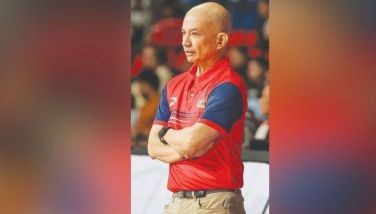The warp & weft of life
December 5, 2004 | 12:00am
"Marginalized? Poor? Not these women", says Czarina Lim to the yet unformulated question. You can tell she’s discussed her weaving project before, and she’s passionate about it and the women involved. "They couldn’t be more central to their families, and communities," she goes on to explain. "They generate income, yes, but they maintain their family life. They work the hours they can handle, and they are close to their homes. You’ll see — their children wander in and out of the weaving center."
"And as for being poor, these are village women. They don’t go to the shopping malls and they don’t watch T.V. ads–they live in peaceful, stable communities, lead productive lives, have enough to eat well, if simply, and feed their children. So they don’t feel poor and therefore they aren’t poor."
About nine years ago, Czarina and Ernie Lim, then engaged in high-powered careers in Manila, decided it was not how they wanted to live, how they wanted to raise their six children. So they put their careers on hold–Ernie actually retired–packed up and moved the whole family to Puerto Princesa City, Palawan. They settled into a house overlooking Puerto Bay and quickly made friends and discovered the elements of life missing in Manila. Ernie began wood carving, selling some pieces at community based art shows. He also started baking wonderful homemade bread. Czarina’s attention went first to her home, her children, and their schooling.
Within three years of the move, the Lims felt it was time to find a way to give back to the community.
Before the dawn of the new century, Ernie, Czarina and Ernie’s sister Laida took up the strands of a conversation sitting under a mango tree. They wanted to augment the meager incomes of the farmer- and fisherfolk of Palawan, without undermining their ecological and social well-being. An alternative livelihood program must strengthen and re-build self-reliance and self-respect, and use local resources sustainably, without dependence on imports. As they spoke, they were laying the fabric of a rural economy.
The weft – the threads woven in horizontally–of the fabric is the recognition of women as the real agents of change in any given community. They were averse to treating women as passive beneficiaries of handouts, but as a potential resource who could be taught a skill that would help in shaping the fabric of the island’s future. They believed that by raising a woman’s income, the whole household’s income would increase, as would the community’s and the nation’s as well.
If the next generation is to have a better life than this one, the mothers must gain sufficient control over financial resources. These underlying idea-fibers, interwoven with the warp, resulted in the web that became the Rurungan Sa Tubod Foundation on September 15, 1999.
Czarina did not know how to weave herself, but was attracted to weaving as a home industry because it is a gentle art, with deep roots in the Philippines, where unique combinations of unusual fibers–pina, for instance, and silk–have yielded original new fabrics.
Besides, Czarina knew she could set up a weaving industry that would be non-disruptive to families and women’s lives. She envisioned a series of small, community-based weaving centers in which women could weave on their own time, close to home, fulfilling their personal needs to be productive and to have some work-based social relations, without neglecting their families. Joining her in this endeavor was her sister in law Laida Lim.
And so she got started. With funding from the founding members of the foundation she set up a city-based weaving center and training program. She brought in weavers from Aklan and trained a core of women who now help in training weavers outside the city.
The "secondary centers" started slowly, most often on request from the people of the community; there are now seven of them with more to come. Typically at the start, the women request help in setting up a project, and Rurungan provides the training and expertise in the areas of saleable styles and colors. The centers and even the looms are usually built by the men of the community. The foundation subsidizes some of the construction materials and weaving equipment.
Rurungan also was contracted by organizations in setting up centers for their beneficiaries. The foundation provides training in all aspects of the weaving process. Close monitoring and quality control is maintained for six months until the center is able to start producing. This service of the foundation has reach all the way to El Nido and soon to Brookes Point.
Rurungan sa Tubod continues to provide guidance, product development and marketing, but the women of each center do their own planning and make their own decisions. The Lims hope that each center will eventually spin off and do its own marketing as a truly independent unit, as the El Nido center has done.
In the meantime, orders come in to the city center. If Czarina goes to one of the rural centers to propose that they accept an urgent order, one that will surely have to be done under time pressure, she asks them if they are willing to commit the time–and if they can get their husbands to pitch in with more help doing the laundry and watching the children. Surprisingly enough, the men agree to help their wives out–Czarina grins and says that after all, their wives are much happier when they are involved in the weaving, so there is less nagging and conflict within the families.
The centers are run on the principle of Sisterhood, with the more experienced weavers helping with teaching and quality control. It is a trusting system, although Czarina has taught the women to keep careful records, a habit they first thought indicated mistrust. But once orders began to pile up, they saw the necessity of keeping financial matters absolutely clear.
An exercise towards development of entrepreneurs is the final stage of the learning process. The foundation sees to it that the women understand in a subliminal manner the nuances of entrepreneurship. It has found out that it is the best way, instead of the traditional manner of having workshops with no long-term follow up. This is especially necessary because people are encouraged to work only when the exigencies of life allow. Of course, weaving and handicraft products are traditionally bought by the piece, so there is no question of an hourly wage, or an eight-hour day.
We visited two centers that day, one in Babuyan and the other in Anilawan, about an hour’s drive north of Puerto Princesa. Both were simple, open structures in shaded and cool surroundings. There were about ten looms in each structure and only about three or four women working; it was getting on towards noon, so others were no doubt home preparing food for their families.
In Babuyan a man was putting together a new loom outside the center. Several little girls milled around, perhaps wondering when they would be old enough to do some weaving too. The women who were weaving smiled, stopped to chat with Czarina, enjoyed looking at the playback of their children’s pictures on my digital camera. In Anilawan an older woman, mother of one of the weavers, was chatting with her daughter, and brought me outside to show me the view of the bay, with Dos Palmas in the distance.
Outside on the breezy roads, older children, school girls in uniforms, walked home for lunch. Village life went on undisturbed.And all around the province, many families count the blessings of steady work–gentle, creative work–and the healthy work place provided by Rurungan sa Tubod.
"And as for being poor, these are village women. They don’t go to the shopping malls and they don’t watch T.V. ads–they live in peaceful, stable communities, lead productive lives, have enough to eat well, if simply, and feed their children. So they don’t feel poor and therefore they aren’t poor."
About nine years ago, Czarina and Ernie Lim, then engaged in high-powered careers in Manila, decided it was not how they wanted to live, how they wanted to raise their six children. So they put their careers on hold–Ernie actually retired–packed up and moved the whole family to Puerto Princesa City, Palawan. They settled into a house overlooking Puerto Bay and quickly made friends and discovered the elements of life missing in Manila. Ernie began wood carving, selling some pieces at community based art shows. He also started baking wonderful homemade bread. Czarina’s attention went first to her home, her children, and their schooling.
Within three years of the move, the Lims felt it was time to find a way to give back to the community.
Before the dawn of the new century, Ernie, Czarina and Ernie’s sister Laida took up the strands of a conversation sitting under a mango tree. They wanted to augment the meager incomes of the farmer- and fisherfolk of Palawan, without undermining their ecological and social well-being. An alternative livelihood program must strengthen and re-build self-reliance and self-respect, and use local resources sustainably, without dependence on imports. As they spoke, they were laying the fabric of a rural economy.
The weft – the threads woven in horizontally–of the fabric is the recognition of women as the real agents of change in any given community. They were averse to treating women as passive beneficiaries of handouts, but as a potential resource who could be taught a skill that would help in shaping the fabric of the island’s future. They believed that by raising a woman’s income, the whole household’s income would increase, as would the community’s and the nation’s as well.
If the next generation is to have a better life than this one, the mothers must gain sufficient control over financial resources. These underlying idea-fibers, interwoven with the warp, resulted in the web that became the Rurungan Sa Tubod Foundation on September 15, 1999.
Czarina did not know how to weave herself, but was attracted to weaving as a home industry because it is a gentle art, with deep roots in the Philippines, where unique combinations of unusual fibers–pina, for instance, and silk–have yielded original new fabrics.
Besides, Czarina knew she could set up a weaving industry that would be non-disruptive to families and women’s lives. She envisioned a series of small, community-based weaving centers in which women could weave on their own time, close to home, fulfilling their personal needs to be productive and to have some work-based social relations, without neglecting their families. Joining her in this endeavor was her sister in law Laida Lim.
And so she got started. With funding from the founding members of the foundation she set up a city-based weaving center and training program. She brought in weavers from Aklan and trained a core of women who now help in training weavers outside the city.
The "secondary centers" started slowly, most often on request from the people of the community; there are now seven of them with more to come. Typically at the start, the women request help in setting up a project, and Rurungan provides the training and expertise in the areas of saleable styles and colors. The centers and even the looms are usually built by the men of the community. The foundation subsidizes some of the construction materials and weaving equipment.
Rurungan also was contracted by organizations in setting up centers for their beneficiaries. The foundation provides training in all aspects of the weaving process. Close monitoring and quality control is maintained for six months until the center is able to start producing. This service of the foundation has reach all the way to El Nido and soon to Brookes Point.
Rurungan sa Tubod continues to provide guidance, product development and marketing, but the women of each center do their own planning and make their own decisions. The Lims hope that each center will eventually spin off and do its own marketing as a truly independent unit, as the El Nido center has done.
In the meantime, orders come in to the city center. If Czarina goes to one of the rural centers to propose that they accept an urgent order, one that will surely have to be done under time pressure, she asks them if they are willing to commit the time–and if they can get their husbands to pitch in with more help doing the laundry and watching the children. Surprisingly enough, the men agree to help their wives out–Czarina grins and says that after all, their wives are much happier when they are involved in the weaving, so there is less nagging and conflict within the families.
The centers are run on the principle of Sisterhood, with the more experienced weavers helping with teaching and quality control. It is a trusting system, although Czarina has taught the women to keep careful records, a habit they first thought indicated mistrust. But once orders began to pile up, they saw the necessity of keeping financial matters absolutely clear.
An exercise towards development of entrepreneurs is the final stage of the learning process. The foundation sees to it that the women understand in a subliminal manner the nuances of entrepreneurship. It has found out that it is the best way, instead of the traditional manner of having workshops with no long-term follow up. This is especially necessary because people are encouraged to work only when the exigencies of life allow. Of course, weaving and handicraft products are traditionally bought by the piece, so there is no question of an hourly wage, or an eight-hour day.
We visited two centers that day, one in Babuyan and the other in Anilawan, about an hour’s drive north of Puerto Princesa. Both were simple, open structures in shaded and cool surroundings. There were about ten looms in each structure and only about three or four women working; it was getting on towards noon, so others were no doubt home preparing food for their families.
In Babuyan a man was putting together a new loom outside the center. Several little girls milled around, perhaps wondering when they would be old enough to do some weaving too. The women who were weaving smiled, stopped to chat with Czarina, enjoyed looking at the playback of their children’s pictures on my digital camera. In Anilawan an older woman, mother of one of the weavers, was chatting with her daughter, and brought me outside to show me the view of the bay, with Dos Palmas in the distance.
Outside on the breezy roads, older children, school girls in uniforms, walked home for lunch. Village life went on undisturbed.And all around the province, many families count the blessings of steady work–gentle, creative work–and the healthy work place provided by Rurungan sa Tubod.
BrandSpace Articles
<
>
- Latest
- Trending
Trending
Latest
Trending
Latest
Recommended

















